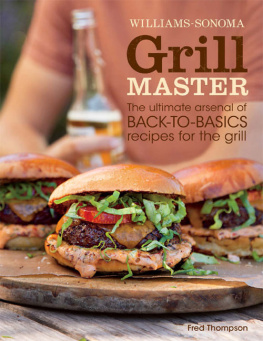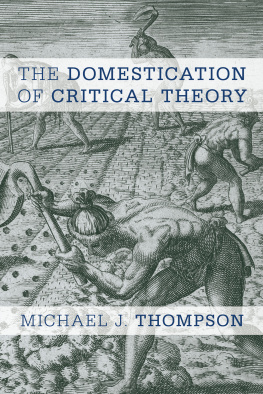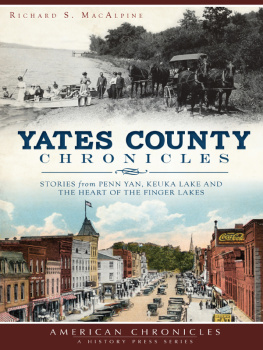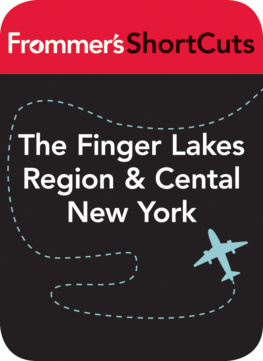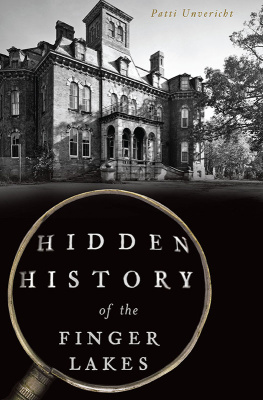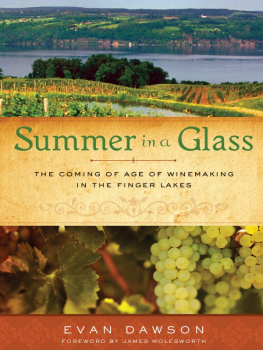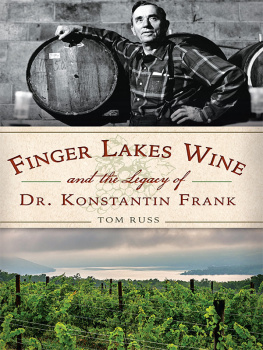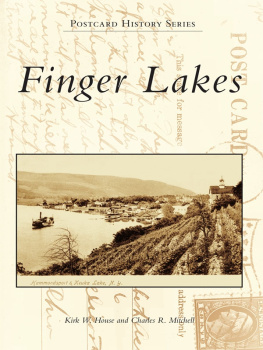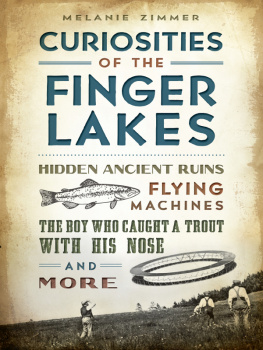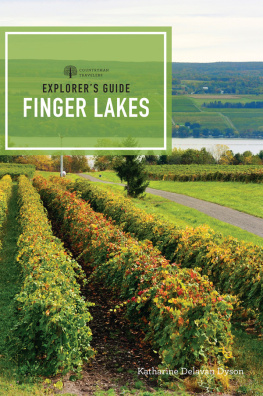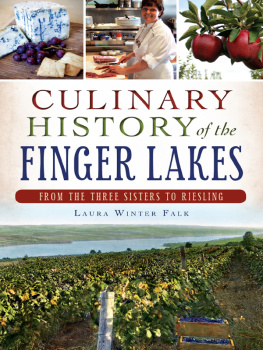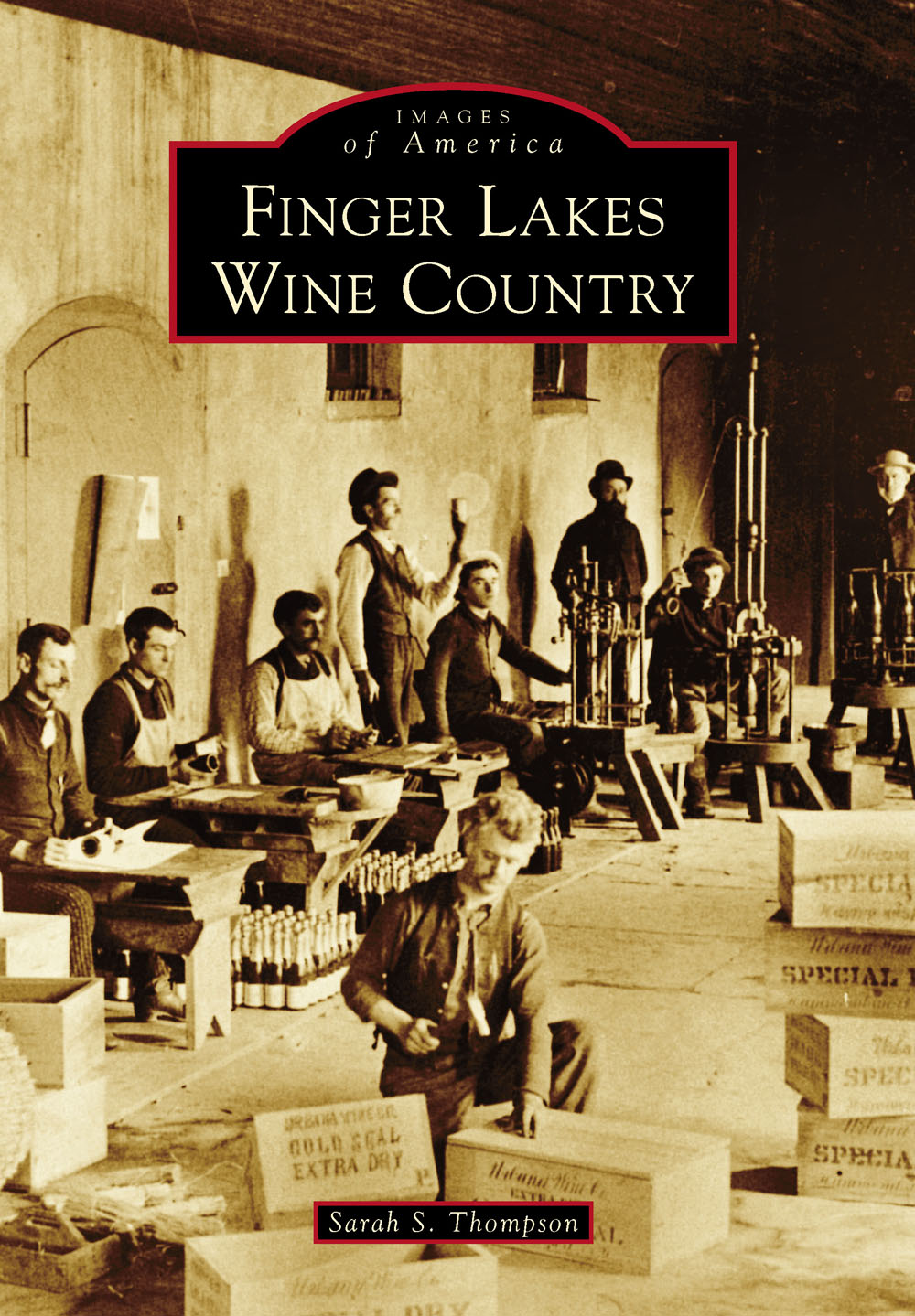
IMAGES
of America
FINGER LAKES
WINE COUNTRY

By the early 20th century, more affordable cars and better roads allowed tourists to embark on leisurely driving tours of the Finger Lakes. This detailed road map of the major Finger Lakes is included in the 1925 edition of The Beautiful Finger Lakes Call You, by Ross W. Kellogg and the Finger Lakes Association of Central New York. The map shows roadways, as well as current and proposed state parks, such as the one on Keuka Lakes Bluff Point. Today, Keuka Lake State Park is located closer to Branchport. (William Hecht.)
ON THE COVER: Founded in 1865, Urbana Wine Company held New York State Bonded Winery License No. 2. Here, Urbana workers are busy bottling the winerys popular Gold Seal special and extra-dry champagnes in the 1880s. (Glen H. Curtiss Museum.)
IMAGES
of America
FINGER LAKES
WINE COUNTRY
Sarah S. Thompson

Copyright 2015 by Sarah S. Thompson
ISBN 978-1-4671-2334-1
Ebook ISBN 9781439650462
Published by Arcadia Publishing
Charleston, South Carolina
Library of Congress Control Number: 2014952499
For all general information, please contact Arcadia Publishing:
Telephone 843-853-2070
Fax 843-853-0044
E-mail
For customer service and orders:
Toll-Free 1-888-313-2665
Visit us on the Internet at www.arcadiapublishing.com
To Christian, who dared me
CONTENTS
ACKNOWLEDGMENTS
In 2005, my husband and I left the suburbs of Washington, DC, seeking a slower pace and different careers: me, cooking in professional kitchens; him, working in a winery. Ten years, two children, and a few detours later, we are finally embarking on our Finger Lakes winemaking dream. Soon, we will plant a small vineyard on the west side of Seneca Lake.
To collect the images in this book, I relied solely on the generosity of the regions winery owners and their staff, the passionate staff of our local historical societies and museums, and archivists in public and university libraries.
The following list of contributors, along with their cited abbreviations, is a testament to the esteem in which the Finger Lakes community holds the regions winemaking past and its future: Fred Frank and Erin Flynn, Dr. Konstantin Frank Vinifera Wine Cellars (DKF); John McGregor, McGregor Vineyard and Winery (MVW); the Peterson family and Lindsay Case, Swedish Hill Winery (SHW); Cathy Zimdahl, King Ferry/Treleaven Winery (KFW); Hermann Wiemer and Oskar Bynke, Hermann J. Wiemer Vineyard (HJWV); Laura Wagner-Lee and John Wagner, Wagner Vineyards (WV); Lillian Taylor, Sean King, and the Greyton H. Taylor Wine Museum, Bully Hill Vineyards (BHV); Brad Phillips, Hazlitt 1852 Vineyards (HV); Jon Luckenbach, Hazlitts Red Cat Cellars (RCC); Jim and Carol Doolittle, Frontenac Point Vineyard & Estate Winery (FPV); Trafford Doherty, director, and Rick Leisenring, curator, Glen H. Curtiss Museum (GHCM); Gary Cox, chairman, Narrative and Images Committee and the Winery Group, Finger Lakes Museum (FLM); John H. Potter, director, and Charles Mitchell, curator, Yates County History Center (YCHC); Michael Fordon, library coordinator, Frank A. Lee Library, New York State Agricultural Experiment Station, Cornell University (FALL); Karen Osburn, archivist, Geneva Historical Society (GHS); Greta Selin-Love, archives assistant, Naples Public Library and Archives (NPL); Terri Grady, Dundee Area Historical Society (DAHS); Jim and Rosemary Covert, Lodi Historical Society (LHS); William Hecht, photographer/archivist (WH); the Fred & Harriett Taylor Memorial Library (FHTML); the Eastern Wine and Grape Archive, Cornell University (EWGA); HathiTrust (HT); and MagazineArt.org (MA).
The following people and resources also provided me with invaluable information: John Brahm, Tina Hazlitt, Sayre Fulkerson, Steve DiFrancesco, Grace Younglove Hudson, Tom Trynskis Fultonhistory.com, Richard Sherers Crooked Lake and the Grape, the Crooked Lake Review, and the USGenWeb Project.
INTRODUCTION
The story of New Yorks Finger Lakes wine country began nearly two million years ago during the Ice Age, when continental glaciers in Canada began moving south. As they flowed, the thick ice sheets gouged out valleys between several northward flowing rivers. The glaciers finally receded from central New York about 11,000 years ago, leaving behind huge soil and rock deposits that dammed these valleys, which then flooded to form 11 lakes.
The Finger Lakes region encompasses these 11 long, narrow lakes, aligned north to south like fingers on a pair of hands. There are six major lakes: Canandaigua, Keuka, Seneca, Cayuga, Owasco, and Skaneateles. The smaller ones are Honeoye, Canadice, Hemlock, Conesus, and Otisco. Finger Lakes wine country centers on the four largest lakes: Canandaigua, Keuka, Seneca, and Cayuga. All have Native American names, given to them by the people of the Seneca, Cayuga, and Onondaga nations who settled there long before European contact.
Canandaigua Lake lies farthest west and is the fourth-largest at 15.5 miles long and a maximum depth of 276 feet. Its Seneca name translates to the chosen place, and the city of Canandaigua sits at the lakes northern end. The town of Naples lies in a valley surrounded by steep hills at the lakes southern end. East of Canandaigua is Keuka Lake, the third-largest. Keuka translates to canoe landing in the Seneca language, though early European settlers dubbed it Crooked Lake because of its unique Y-shape. The hamlet of Branchport is located on Keukas northwestern arm, the village of Penn Yan on its northeastern arm, and the village of Hammondsport at its headwaters.
At Penn Yan, Keuka Lake flows eastward along an eight-mile outlet creek that drops 270 feet to empty into Seneca Lake, the deepest lake. Seneca means place of the stone, which may refer to the lakes steep shores or the many gorges and glens carved from those heights. Seneca Lakes maximum depth is 650 feet at the US Navys sonar test facility moored offshore near the village of Dresden. The city of Geneva rests at Senecas northern end, with the village of Watkins Glen at its headwaters. Farther east, Cayuga Lake is the longest and largest lake of the four, at 38 miles long and 3.5 miles wide at its widest point. Its Iroquois name translates to boat landing. The city of Ithaca, home to Cornell University and Ithaca College, is located at Cayugas headwaters. At its northern end, Seneca Lake empties into Cayuga via several streams that wind through the towns of Waterloo and Seneca Falls, then eventually joins the Erie Canal.
The geologic history of the Finger Lakes regionits prehistoric inland sea and glacial lakesshaped the land into an agricultural utopia. The soils are rich and diverse, derived from deposits of shale, sandstone, and limestone. Feeder streams dropping through steep glens provide irrigation and energy, while the deep lakes moderate the temperature of land closer to shore, keeping it several degrees cooler in summer and warmer in winter. Seneca Lake maintains a constant 39 degrees Fahrenheit beyond a depth of 15 feet. The Iroquois people first took advantage of these microclimates for agriculture, cultivating wild plums, cherries, and peaches into flourishing lakeside orchards.
The first major influx of European settlers to the Finger Lakes came after the Revolutionary War, when New York veterans claimed one 600-acre lot each in the Military Tract of Central New York, an area encompassing 28 townships carved from the conquered Iroquois territory. Another wave of settlers came after the Erie Canal opened in 1825. The canal connected western New York to goods and markets in the Great Lakes region and the Eastern Seaboard. Canandaigua, Keuka, Seneca, and Cayuga Lakes soon became busy thoroughfares for commerce, filled with steamboats and barges.
Next page

